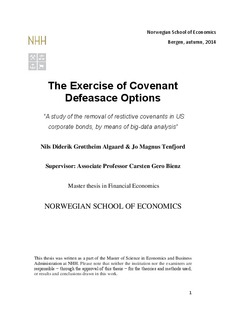The exercise of covenant defeasace options : a study of the removal of restictive covenants in US corporate bonds, by means of big-data analysis
Master thesis
Permanent lenke
http://hdl.handle.net/11250/278414Utgivelsesdato
2014Metadata
Vis full innførselSamlinger
- Master Thesis [4379]
Sammendrag
This thesis aims to examine the exercise of covenant defeasance options. To find what bonds are defeased, we build a SEC crawler to analyze more than 1.4m SEC filings. Our methods of analysis are descriptive statistics and regression analysis. The regression analysis is performed by joining our data with Mergent’s Fixed Income Securities Database (FISD). Our major findings are: (1) 0.56% of defeasible bonds have this option exercised; (2) defeasance and repurchase are linked together as firms often repurchase as many bonds as possible while any hold outs are removed via defeasance; (3) no evidence that defeasance exercise is clustered in industries with higher uncertainty (4) bonds with a higher number of restrictive covenants are more likely to exercise their defeasance option; (5) there is no indication that callable bonds substitute for defeasance exercise; (6) the defeasance exercises are often linked to major corporate actions, such as acquisitions, mergers or refinancing.
